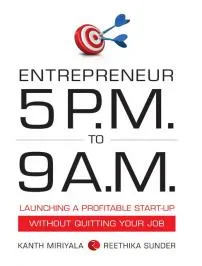[Book Review] Entrepreneur 5 pm to 9 am: Launching a Profitable Startup Without Quitting Your Job
by Kanth Miriyala and Reethika Sunder; 2013 Rupa Publications; 31 chapters, 133 pages
This slender practical book on entrepreneurship packs together key tables and charts from a range of books about innovation, and blends them together with personal accounts from a tech entrepreneur. The result is a crisp read (you can go through the book in just about an hour) while also being a useful source of checklists for aspiring entrepreneurs.

Kanth Miriyala did his engineering from IIT Madras and has a PhD. He had his first brush with entrepreneurship quite by accident. He was one of the co-founders for Quintant, which was sold to iGATE in 2003. He then became an early stage investor in Qik, a mobile video streaming company, later sold to Skype for over $100 million. Reethika Sunder, who helped Miriyala write this book, did her MBA in marketing from IIM Ahmedabad and now works as a consultant with an Indian IT firm.Miriyala was also involved with the successful startup Mercadence (software services firm), and confesses that some of his failures were a venture for building resorts in forests, and another one focused on services for patenting.
“You can become an entrepreneur even if you have a full-time job and are risk-averse. You can test different business ideas till you find the one that has good potential, start developing it and when it becomes big enough, you can quit your job and work on the startup fulltime,” the book begins, drawing on the author’s personal experience. A key is to accept failures as part of learning but to keep the cost of failure low.
The first step is to find the sweet spot which matches your strengths, passions, money-making abilities and overall sense of purpose in life.
To succeed with a venture, you need to iteratively find out the target segment, ways to reach them, identify their problem, build a solution, approach and convert the target segment, and find the appropriate price/cost. For each of these categories, it is important to remove ‘unknowns’ and ‘fuzzy knowns’ and convert them into ‘knowns.’
‘Reality testing’ is needed to find out if you are on the right path, eg. one of the author’s friends experimented with various options for a tutoring service till he found the right one via an independent online channel.
Typical fears facing an entrepreneur revolve around uncertainty, effects of past failures, and scares of losing money. These can be dealt with by networking with positive-energy entrepreneurs, attending seminars, reading books, and taking action on the proposed project.
“Action cures fear quite rapidly,” the author advises. Many people’s mental captivity is of their own making; they are unhappy with their day jobs but also feel they need the security of the job.
Effective ways to test if you are good at something is if people come to you for help and advice, and are willing to pay for it (the site eElance is a good place to bid for work and test your skills). You can test your passion for something if you notice you spend a lot of time and effort on it without being paid, or without noticing that time is passing when you engage in it. Such self-reflection helps you build a priority list for your activities.
Mentors and co-founders help overcome blind-spots and build effective teams, especially when the time comes to pitch to potential investors. A co-founder should be happy with a ‘lights-on’ salary in the early stages (just enough to pay the electricity bill at home!).
Thanks to the Internet and social media, there are more platforms and channels than ever before for testing and launching ideas widely and quickly. Customer development must go hand in hand with ‘direct transactional experiences’ for iterative product development, with new models of crowdsourcing and co-creation emerging.
Miriyala draws on his own startup Qik to show how they launched with video chat, then abandoned that line due to competition from Skype, and pivoted to a cellphone video streaming service thanks to positive feedback from users for an early prototype. Qik was eventually bought by Skype.
It is important to draw on not just market research and focus groups but actual usage data and face-to-face conversations to unearth adoption patterns of new products. The author gives the superb examples of MapQuest v/s GPS and iPod v/s early MP3 players to bring out these points.
For example, early MP3 players pitched memory size while iPod pitched number of songs storable; early MP3 players were plagued with concerns of privacy while iPod began first with legally-cleared iTunes. Eventually, the iPod interface became not only intuitive but habit forming.
Customers were not able to articulate early problems with MapQuest, but actual observation helped GPS navigators identify and overcome the problems: voice instructions instead of printouts which were difficult to read while driving, quick recovery from wrong turns, and no need for printouts.
This calls for ‘smart asking and listening,’ and distinguishing between conscious and subconscious activity of customers. “The questions you choose and how you phrase them will influence the answers that you get,” the author cautions.
Effective use cases in the form of stories help in the startup pitch. Stories are fun, modifiable, and simplify the use case scenario; they can be effectively re-told and re-transmitted, and paint clear pictures in the target user’s mind.
Typical story structures in this regard are before and after, pain and benefit, and surprise factor. Stories are “worth their weight in gold” in pitching to users and investors.
One interesting chapter deals with the importance of pursuing potentially successful ideas even if you as an entrepreneur don’t think the idea will work, though market tests prove you otherwise. For instance, Twitter actually began as a side-project for podcasting startup Odeo, and then a test revealed that the micro-blogging service was even more in demand than the audio/video service originally planned.
The author brings up a number of useful terms, tools, charts and diagrams for entrepreneurs, such as brightspots (valuable datapoints, hypotheses which work) and the ESBI diagram (with four quadrants: employee, self-employed, business owner, investor).
Other chapters deal with black swans (events of high positive/negative impact), blue oceans (create, keep, raise, eliminate or reduce product features), crossing the chasm (eg. Documentum exploring new markets one business vertical at a time), viral effects (eg. Hotmail, Twitter), and inbound marketing (eg. Narsi Santhanam’s hatching of the successful CastorOil.in web resource and community while working at Sify).
“Never before has there been a more fertile growth field for viral growth, or for getting large numbers of people habituated to what you can offer them,” Miriyala explains, in the world of ubiquitous mobile social media.
The author also provides cautionary notes about potential mistakes entrepreneurs tend to make: lack of persistence, chasing too many ideas, shutting down their startups completely instead of keeping them dormant till better times, making big bets rather than frequent smaller ones, not listening due to arrogance or ego, being too secretive, and not knowing when or how to raise money.
The book concludes on an optimistic note, by urging aspiring entrepreneurs to focus on discipline, self-motivation, people skills, and a healthy work-life balance.
“Everything you will need, you can find. Now let the end of this book be your beginning,” the author signs off.


![[Book Review] Entrepreneur 5 pm to 9 am: Launching a Profitable Startup Without Quitting Your Job](https://images.yourstory.com/cs/wordpress/2013/08/Entre1.jpg?mode=crop&crop=faces&ar=16%3A9&format=auto&w=1920&q=75)




